Decline of Trade Union Membership in Australia
VerifiedAdded on 2022/12/29
|8
|2114
|41
AI Summary
This article discusses the decline of trade union membership in Australia over the last 35 years. It explores the reasons behind this decline, including the collapse of compulsory unionism, factors related to institutions, and new strategies of employers. The article also highlights the impact of these factors on the structure of the labor market and the overall density of trade unions in Australia.
Contribute Materials
Your contribution can guide someone’s learning journey. Share your
documents today.
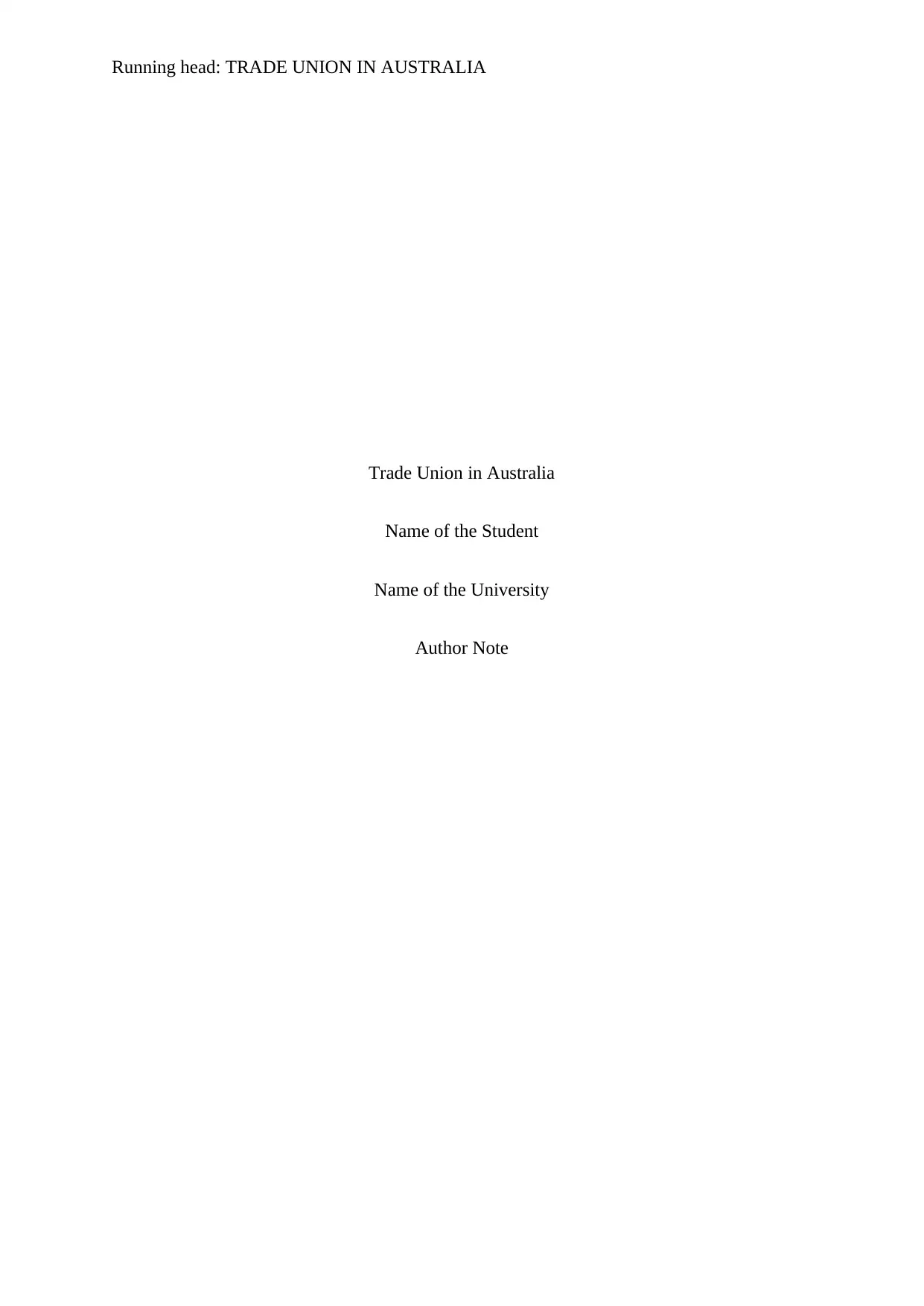
Running head: TRADE UNION IN AUSTRALIA
Trade Union in Australia
Name of the Student
Name of the University
Author Note
Trade Union in Australia
Name of the Student
Name of the University
Author Note
Secure Best Marks with AI Grader
Need help grading? Try our AI Grader for instant feedback on your assignments.
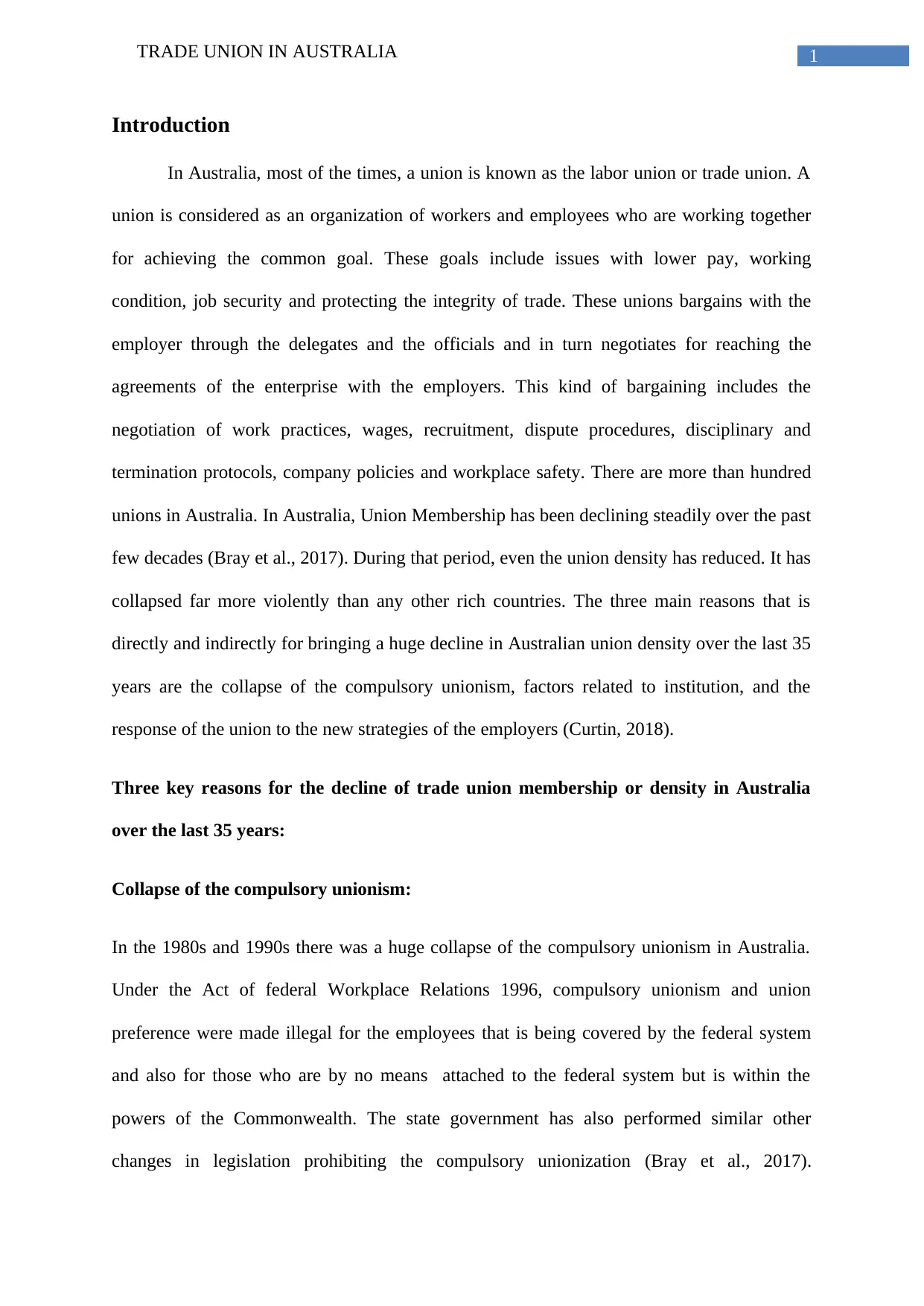
1TRADE UNION IN AUSTRALIA
Introduction
In Australia, most of the times, a union is known as the labor union or trade union. A
union is considered as an organization of workers and employees who are working together
for achieving the common goal. These goals include issues with lower pay, working
condition, job security and protecting the integrity of trade. These unions bargains with the
employer through the delegates and the officials and in turn negotiates for reaching the
agreements of the enterprise with the employers. This kind of bargaining includes the
negotiation of work practices, wages, recruitment, dispute procedures, disciplinary and
termination protocols, company policies and workplace safety. There are more than hundred
unions in Australia. In Australia, Union Membership has been declining steadily over the past
few decades (Bray et al., 2017). During that period, even the union density has reduced. It has
collapsed far more violently than any other rich countries. The three main reasons that is
directly and indirectly for bringing a huge decline in Australian union density over the last 35
years are the collapse of the compulsory unionism, factors related to institution, and the
response of the union to the new strategies of the employers (Curtin, 2018).
Three key reasons for the decline of trade union membership or density in Australia
over the last 35 years:
Collapse of the compulsory unionism:
In the 1980s and 1990s there was a huge collapse of the compulsory unionism in Australia.
Under the Act of federal Workplace Relations 1996, compulsory unionism and union
preference were made illegal for the employees that is being covered by the federal system
and also for those who are by no means attached to the federal system but is within the
powers of the Commonwealth. The state government has also performed similar other
changes in legislation prohibiting the compulsory unionization (Bray et al., 2017).
Introduction
In Australia, most of the times, a union is known as the labor union or trade union. A
union is considered as an organization of workers and employees who are working together
for achieving the common goal. These goals include issues with lower pay, working
condition, job security and protecting the integrity of trade. These unions bargains with the
employer through the delegates and the officials and in turn negotiates for reaching the
agreements of the enterprise with the employers. This kind of bargaining includes the
negotiation of work practices, wages, recruitment, dispute procedures, disciplinary and
termination protocols, company policies and workplace safety. There are more than hundred
unions in Australia. In Australia, Union Membership has been declining steadily over the past
few decades (Bray et al., 2017). During that period, even the union density has reduced. It has
collapsed far more violently than any other rich countries. The three main reasons that is
directly and indirectly for bringing a huge decline in Australian union density over the last 35
years are the collapse of the compulsory unionism, factors related to institution, and the
response of the union to the new strategies of the employers (Curtin, 2018).
Three key reasons for the decline of trade union membership or density in Australia
over the last 35 years:
Collapse of the compulsory unionism:
In the 1980s and 1990s there was a huge collapse of the compulsory unionism in Australia.
Under the Act of federal Workplace Relations 1996, compulsory unionism and union
preference were made illegal for the employees that is being covered by the federal system
and also for those who are by no means attached to the federal system but is within the
powers of the Commonwealth. The state government has also performed similar other
changes in legislation prohibiting the compulsory unionization (Bray et al., 2017).
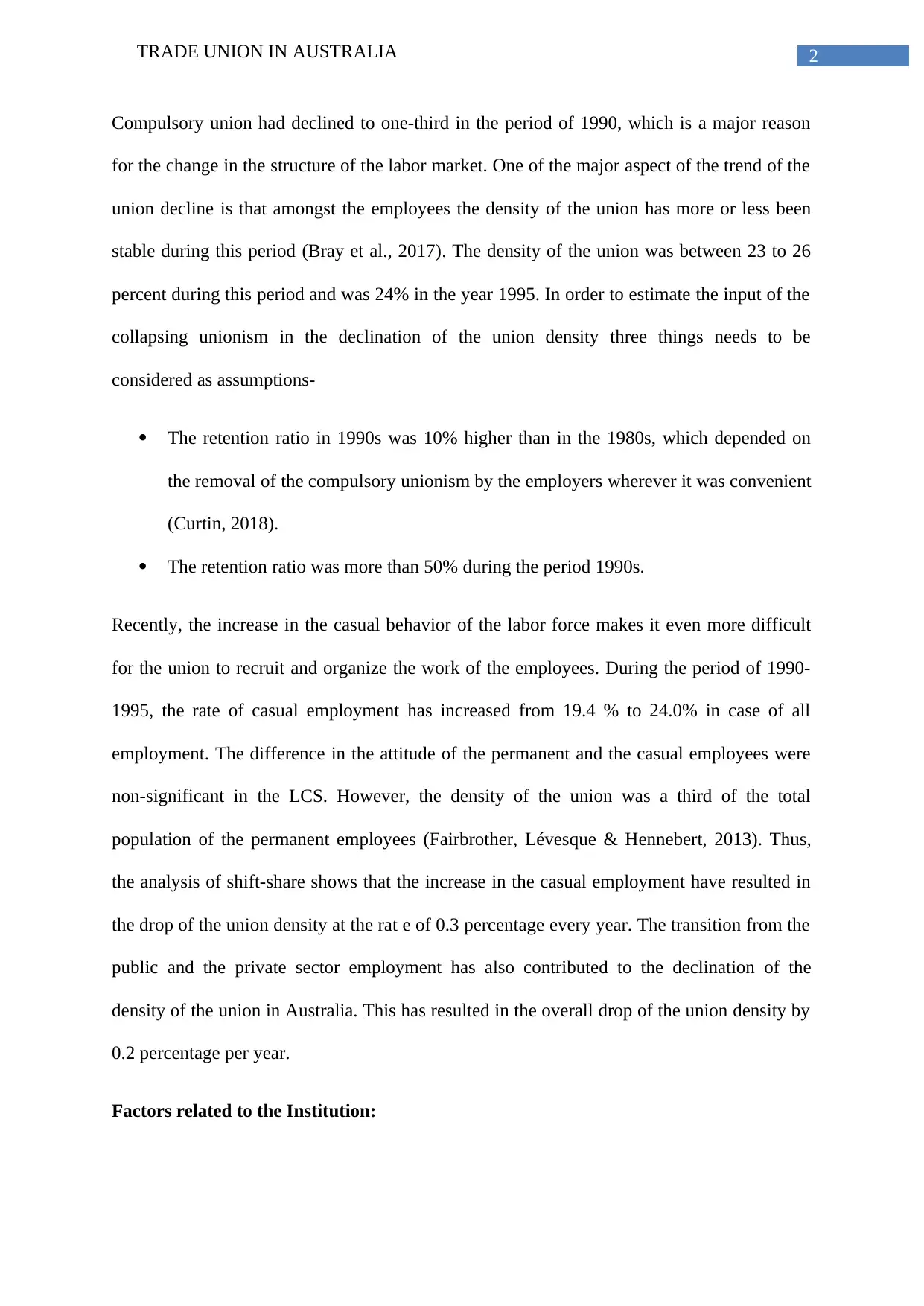
2TRADE UNION IN AUSTRALIA
Compulsory union had declined to one-third in the period of 1990, which is a major reason
for the change in the structure of the labor market. One of the major aspect of the trend of the
union decline is that amongst the employees the density of the union has more or less been
stable during this period (Bray et al., 2017). The density of the union was between 23 to 26
percent during this period and was 24% in the year 1995. In order to estimate the input of the
collapsing unionism in the declination of the union density three things needs to be
considered as assumptions-
The retention ratio in 1990s was 10% higher than in the 1980s, which depended on
the removal of the compulsory unionism by the employers wherever it was convenient
(Curtin, 2018).
The retention ratio was more than 50% during the period 1990s.
Recently, the increase in the casual behavior of the labor force makes it even more difficult
for the union to recruit and organize the work of the employees. During the period of 1990-
1995, the rate of casual employment has increased from 19.4 % to 24.0% in case of all
employment. The difference in the attitude of the permanent and the casual employees were
non-significant in the LCS. However, the density of the union was a third of the total
population of the permanent employees (Fairbrother, Lévesque & Hennebert, 2013). Thus,
the analysis of shift-share shows that the increase in the casual employment have resulted in
the drop of the union density at the rat e of 0.3 percentage every year. The transition from the
public and the private sector employment has also contributed to the declination of the
density of the union in Australia. This has resulted in the overall drop of the union density by
0.2 percentage per year.
Factors related to the Institution:
Compulsory union had declined to one-third in the period of 1990, which is a major reason
for the change in the structure of the labor market. One of the major aspect of the trend of the
union decline is that amongst the employees the density of the union has more or less been
stable during this period (Bray et al., 2017). The density of the union was between 23 to 26
percent during this period and was 24% in the year 1995. In order to estimate the input of the
collapsing unionism in the declination of the union density three things needs to be
considered as assumptions-
The retention ratio in 1990s was 10% higher than in the 1980s, which depended on
the removal of the compulsory unionism by the employers wherever it was convenient
(Curtin, 2018).
The retention ratio was more than 50% during the period 1990s.
Recently, the increase in the casual behavior of the labor force makes it even more difficult
for the union to recruit and organize the work of the employees. During the period of 1990-
1995, the rate of casual employment has increased from 19.4 % to 24.0% in case of all
employment. The difference in the attitude of the permanent and the casual employees were
non-significant in the LCS. However, the density of the union was a third of the total
population of the permanent employees (Fairbrother, Lévesque & Hennebert, 2013). Thus,
the analysis of shift-share shows that the increase in the casual employment have resulted in
the drop of the union density at the rat e of 0.3 percentage every year. The transition from the
public and the private sector employment has also contributed to the declination of the
density of the union in Australia. This has resulted in the overall drop of the union density by
0.2 percentage per year.
Factors related to the Institution:
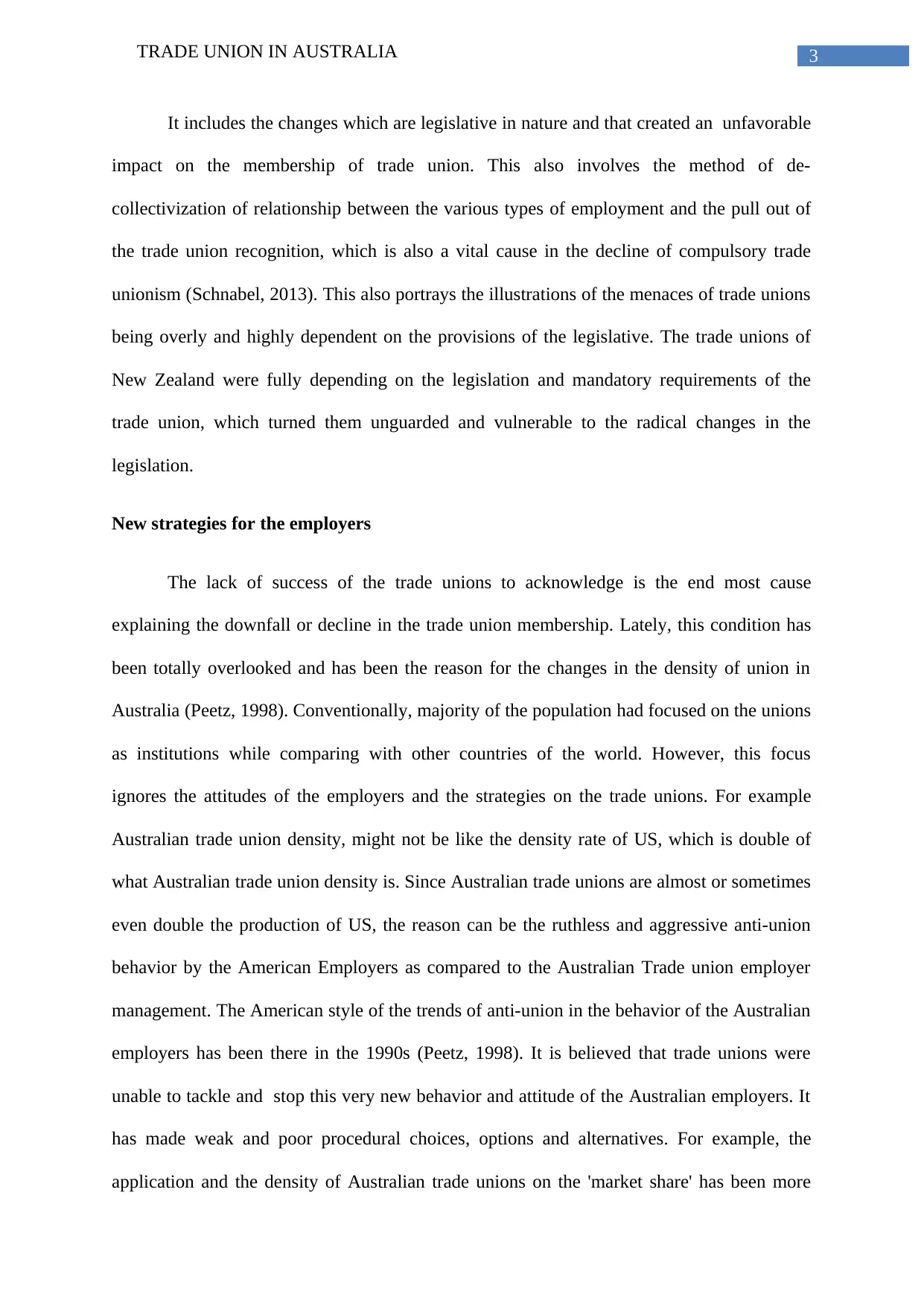
3TRADE UNION IN AUSTRALIA
It includes the changes which are legislative in nature and that created an unfavorable
impact on the membership of trade union. This also involves the method of de-
collectivization of relationship between the various types of employment and the pull out of
the trade union recognition, which is also a vital cause in the decline of compulsory trade
unionism (Schnabel, 2013). This also portrays the illustrations of the menaces of trade unions
being overly and highly dependent on the provisions of the legislative. The trade unions of
New Zealand were fully depending on the legislation and mandatory requirements of the
trade union, which turned them unguarded and vulnerable to the radical changes in the
legislation.
New strategies for the employers
The lack of success of the trade unions to acknowledge is the end most cause
explaining the downfall or decline in the trade union membership. Lately, this condition has
been totally overlooked and has been the reason for the changes in the density of union in
Australia (Peetz, 1998). Conventionally, majority of the population had focused on the unions
as institutions while comparing with other countries of the world. However, this focus
ignores the attitudes of the employers and the strategies on the trade unions. For example
Australian trade union density, might not be like the density rate of US, which is double of
what Australian trade union density is. Since Australian trade unions are almost or sometimes
even double the production of US, the reason can be the ruthless and aggressive anti-union
behavior by the American Employers as compared to the Australian Trade union employer
management. The American style of the trends of anti-union in the behavior of the Australian
employers has been there in the 1990s (Peetz, 1998). It is believed that trade unions were
unable to tackle and stop this very new behavior and attitude of the Australian employers. It
has made weak and poor procedural choices, options and alternatives. For example, the
application and the density of Australian trade unions on the 'market share' has been more
It includes the changes which are legislative in nature and that created an unfavorable
impact on the membership of trade union. This also involves the method of de-
collectivization of relationship between the various types of employment and the pull out of
the trade union recognition, which is also a vital cause in the decline of compulsory trade
unionism (Schnabel, 2013). This also portrays the illustrations of the menaces of trade unions
being overly and highly dependent on the provisions of the legislative. The trade unions of
New Zealand were fully depending on the legislation and mandatory requirements of the
trade union, which turned them unguarded and vulnerable to the radical changes in the
legislation.
New strategies for the employers
The lack of success of the trade unions to acknowledge is the end most cause
explaining the downfall or decline in the trade union membership. Lately, this condition has
been totally overlooked and has been the reason for the changes in the density of union in
Australia (Peetz, 1998). Conventionally, majority of the population had focused on the unions
as institutions while comparing with other countries of the world. However, this focus
ignores the attitudes of the employers and the strategies on the trade unions. For example
Australian trade union density, might not be like the density rate of US, which is double of
what Australian trade union density is. Since Australian trade unions are almost or sometimes
even double the production of US, the reason can be the ruthless and aggressive anti-union
behavior by the American Employers as compared to the Australian Trade union employer
management. The American style of the trends of anti-union in the behavior of the Australian
employers has been there in the 1990s (Peetz, 1998). It is believed that trade unions were
unable to tackle and stop this very new behavior and attitude of the Australian employers. It
has made weak and poor procedural choices, options and alternatives. For example, the
application and the density of Australian trade unions on the 'market share' has been more
Secure Best Marks with AI Grader
Need help grading? Try our AI Grader for instant feedback on your assignments.
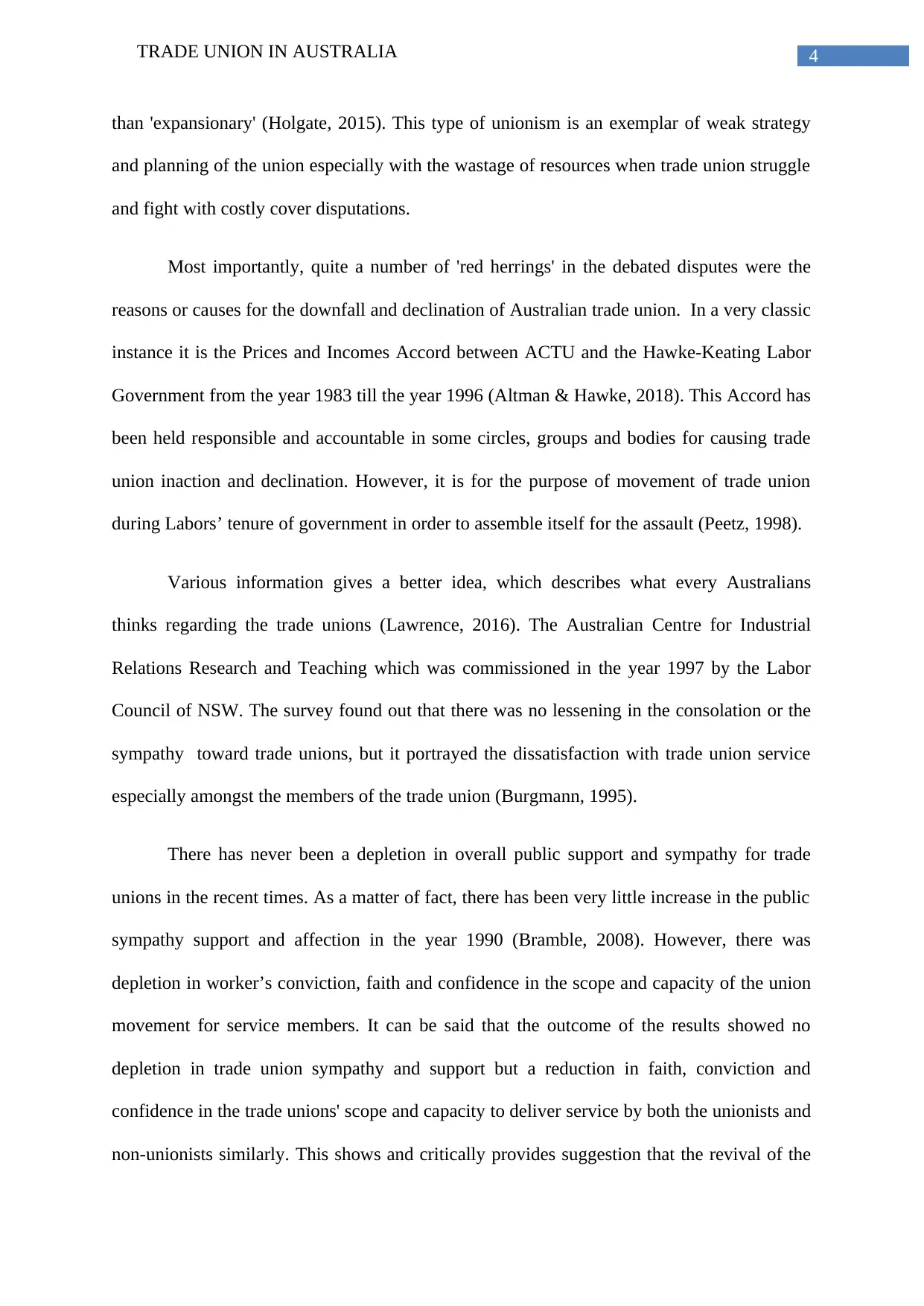
4TRADE UNION IN AUSTRALIA
than 'expansionary' (Holgate, 2015). This type of unionism is an exemplar of weak strategy
and planning of the union especially with the wastage of resources when trade union struggle
and fight with costly cover disputations.
Most importantly, quite a number of 'red herrings' in the debated disputes were the
reasons or causes for the downfall and declination of Australian trade union. In a very classic
instance it is the Prices and Incomes Accord between ACTU and the Hawke-Keating Labor
Government from the year 1983 till the year 1996 (Altman & Hawke, 2018). This Accord has
been held responsible and accountable in some circles, groups and bodies for causing trade
union inaction and declination. However, it is for the purpose of movement of trade union
during Labors’ tenure of government in order to assemble itself for the assault (Peetz, 1998).
Various information gives a better idea, which describes what every Australians
thinks regarding the trade unions (Lawrence, 2016). The Australian Centre for Industrial
Relations Research and Teaching which was commissioned in the year 1997 by the Labor
Council of NSW. The survey found out that there was no lessening in the consolation or the
sympathy toward trade unions, but it portrayed the dissatisfaction with trade union service
especially amongst the members of the trade union (Burgmann, 1995).
There has never been a depletion in overall public support and sympathy for trade
unions in the recent times. As a matter of fact, there has been very little increase in the public
sympathy support and affection in the year 1990 (Bramble, 2008). However, there was
depletion in worker’s conviction, faith and confidence in the scope and capacity of the union
movement for service members. It can be said that the outcome of the results showed no
depletion in trade union sympathy and support but a reduction in faith, conviction and
confidence in the trade unions' scope and capacity to deliver service by both the unionists and
non-unionists similarly. This shows and critically provides suggestion that the revival of the
than 'expansionary' (Holgate, 2015). This type of unionism is an exemplar of weak strategy
and planning of the union especially with the wastage of resources when trade union struggle
and fight with costly cover disputations.
Most importantly, quite a number of 'red herrings' in the debated disputes were the
reasons or causes for the downfall and declination of Australian trade union. In a very classic
instance it is the Prices and Incomes Accord between ACTU and the Hawke-Keating Labor
Government from the year 1983 till the year 1996 (Altman & Hawke, 2018). This Accord has
been held responsible and accountable in some circles, groups and bodies for causing trade
union inaction and declination. However, it is for the purpose of movement of trade union
during Labors’ tenure of government in order to assemble itself for the assault (Peetz, 1998).
Various information gives a better idea, which describes what every Australians
thinks regarding the trade unions (Lawrence, 2016). The Australian Centre for Industrial
Relations Research and Teaching which was commissioned in the year 1997 by the Labor
Council of NSW. The survey found out that there was no lessening in the consolation or the
sympathy toward trade unions, but it portrayed the dissatisfaction with trade union service
especially amongst the members of the trade union (Burgmann, 1995).
There has never been a depletion in overall public support and sympathy for trade
unions in the recent times. As a matter of fact, there has been very little increase in the public
sympathy support and affection in the year 1990 (Bramble, 2008). However, there was
depletion in worker’s conviction, faith and confidence in the scope and capacity of the union
movement for service members. It can be said that the outcome of the results showed no
depletion in trade union sympathy and support but a reduction in faith, conviction and
confidence in the trade unions' scope and capacity to deliver service by both the unionists and
non-unionists similarly. This shows and critically provides suggestion that the revival of the
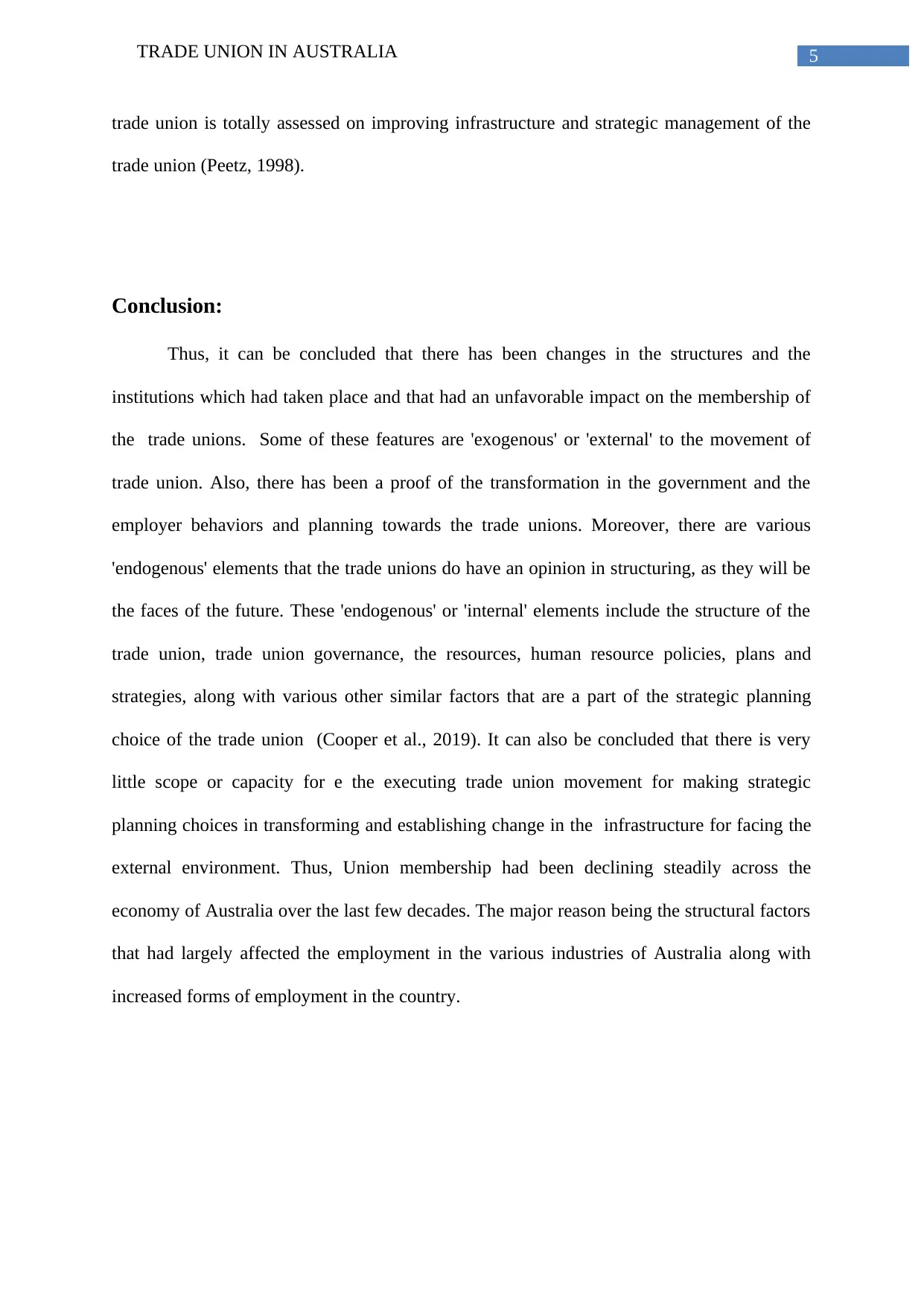
5TRADE UNION IN AUSTRALIA
trade union is totally assessed on improving infrastructure and strategic management of the
trade union (Peetz, 1998).
Conclusion:
Thus, it can be concluded that there has been changes in the structures and the
institutions which had taken place and that had an unfavorable impact on the membership of
the trade unions. Some of these features are 'exogenous' or 'external' to the movement of
trade union. Also, there has been a proof of the transformation in the government and the
employer behaviors and planning towards the trade unions. Moreover, there are various
'endogenous' elements that the trade unions do have an opinion in structuring, as they will be
the faces of the future. These 'endogenous' or 'internal' elements include the structure of the
trade union, trade union governance, the resources, human resource policies, plans and
strategies, along with various other similar factors that are a part of the strategic planning
choice of the trade union (Cooper et al., 2019). It can also be concluded that there is very
little scope or capacity for e the executing trade union movement for making strategic
planning choices in transforming and establishing change in the infrastructure for facing the
external environment. Thus, Union membership had been declining steadily across the
economy of Australia over the last few decades. The major reason being the structural factors
that had largely affected the employment in the various industries of Australia along with
increased forms of employment in the country.
trade union is totally assessed on improving infrastructure and strategic management of the
trade union (Peetz, 1998).
Conclusion:
Thus, it can be concluded that there has been changes in the structures and the
institutions which had taken place and that had an unfavorable impact on the membership of
the trade unions. Some of these features are 'exogenous' or 'external' to the movement of
trade union. Also, there has been a proof of the transformation in the government and the
employer behaviors and planning towards the trade unions. Moreover, there are various
'endogenous' elements that the trade unions do have an opinion in structuring, as they will be
the faces of the future. These 'endogenous' or 'internal' elements include the structure of the
trade union, trade union governance, the resources, human resource policies, plans and
strategies, along with various other similar factors that are a part of the strategic planning
choice of the trade union (Cooper et al., 2019). It can also be concluded that there is very
little scope or capacity for e the executing trade union movement for making strategic
planning choices in transforming and establishing change in the infrastructure for facing the
external environment. Thus, Union membership had been declining steadily across the
economy of Australia over the last few decades. The major reason being the structural factors
that had largely affected the employment in the various industries of Australia along with
increased forms of employment in the country.
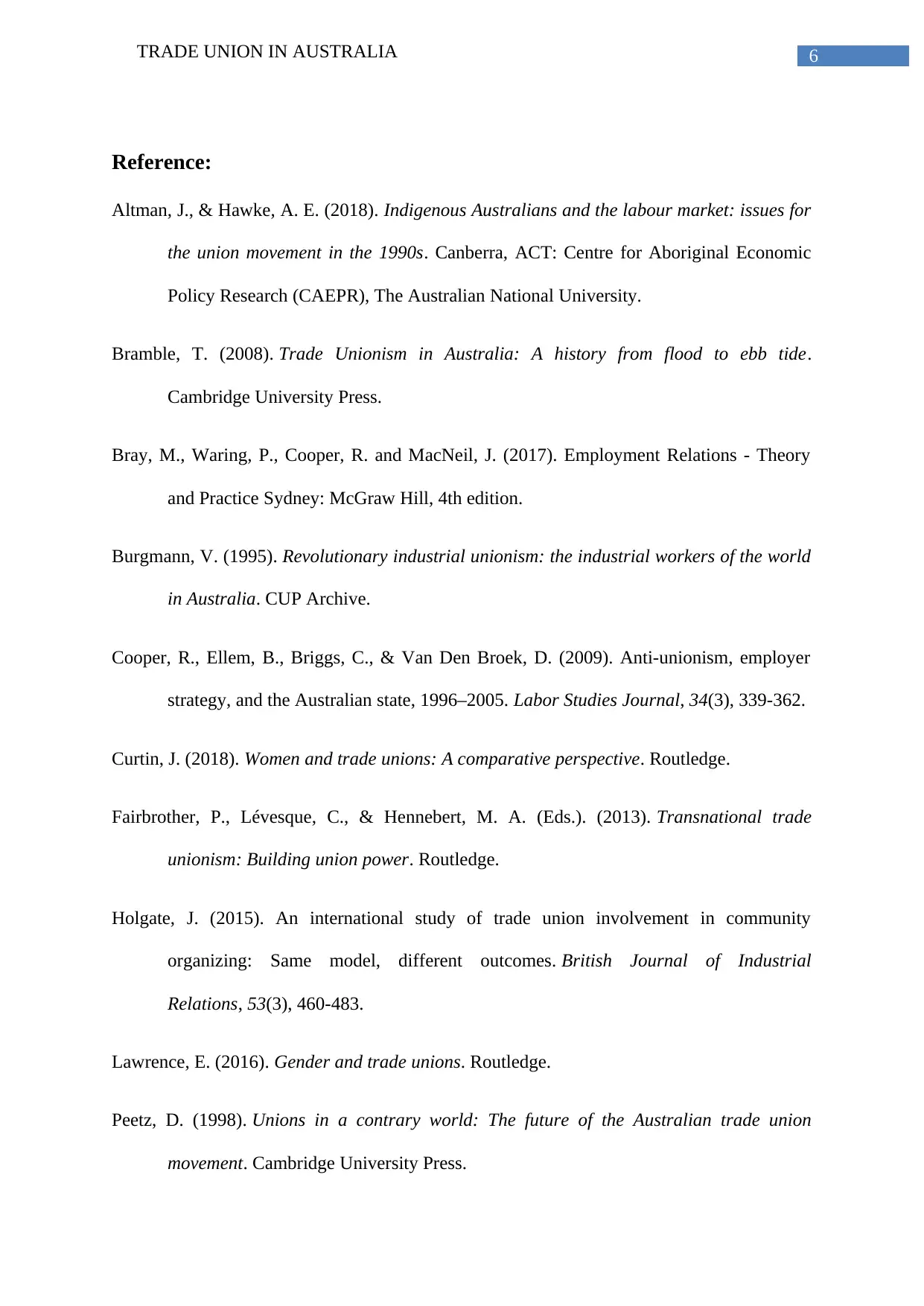
6TRADE UNION IN AUSTRALIA
Reference:
Altman, J., & Hawke, A. E. (2018). Indigenous Australians and the labour market: issues for
the union movement in the 1990s. Canberra, ACT: Centre for Aboriginal Economic
Policy Research (CAEPR), The Australian National University.
Bramble, T. (2008). Trade Unionism in Australia: A history from flood to ebb tide.
Cambridge University Press.
Bray, M., Waring, P., Cooper, R. and MacNeil, J. (2017). Employment Relations - Theory
and Practice Sydney: McGraw Hill, 4th edition.
Burgmann, V. (1995). Revolutionary industrial unionism: the industrial workers of the world
in Australia. CUP Archive.
Cooper, R., Ellem, B., Briggs, C., & Van Den Broek, D. (2009). Anti-unionism, employer
strategy, and the Australian state, 1996–2005. Labor Studies Journal, 34(3), 339-362.
Curtin, J. (2018). Women and trade unions: A comparative perspective. Routledge.
Fairbrother, P., Lévesque, C., & Hennebert, M. A. (Eds.). (2013). Transnational trade
unionism: Building union power. Routledge.
Holgate, J. (2015). An international study of trade union involvement in community
organizing: Same model, different outcomes. British Journal of Industrial
Relations, 53(3), 460-483.
Lawrence, E. (2016). Gender and trade unions. Routledge.
Peetz, D. (1998). Unions in a contrary world: The future of the Australian trade union
movement. Cambridge University Press.
Reference:
Altman, J., & Hawke, A. E. (2018). Indigenous Australians and the labour market: issues for
the union movement in the 1990s. Canberra, ACT: Centre for Aboriginal Economic
Policy Research (CAEPR), The Australian National University.
Bramble, T. (2008). Trade Unionism in Australia: A history from flood to ebb tide.
Cambridge University Press.
Bray, M., Waring, P., Cooper, R. and MacNeil, J. (2017). Employment Relations - Theory
and Practice Sydney: McGraw Hill, 4th edition.
Burgmann, V. (1995). Revolutionary industrial unionism: the industrial workers of the world
in Australia. CUP Archive.
Cooper, R., Ellem, B., Briggs, C., & Van Den Broek, D. (2009). Anti-unionism, employer
strategy, and the Australian state, 1996–2005. Labor Studies Journal, 34(3), 339-362.
Curtin, J. (2018). Women and trade unions: A comparative perspective. Routledge.
Fairbrother, P., Lévesque, C., & Hennebert, M. A. (Eds.). (2013). Transnational trade
unionism: Building union power. Routledge.
Holgate, J. (2015). An international study of trade union involvement in community
organizing: Same model, different outcomes. British Journal of Industrial
Relations, 53(3), 460-483.
Lawrence, E. (2016). Gender and trade unions. Routledge.
Peetz, D. (1998). Unions in a contrary world: The future of the Australian trade union
movement. Cambridge University Press.
Paraphrase This Document
Need a fresh take? Get an instant paraphrase of this document with our AI Paraphraser
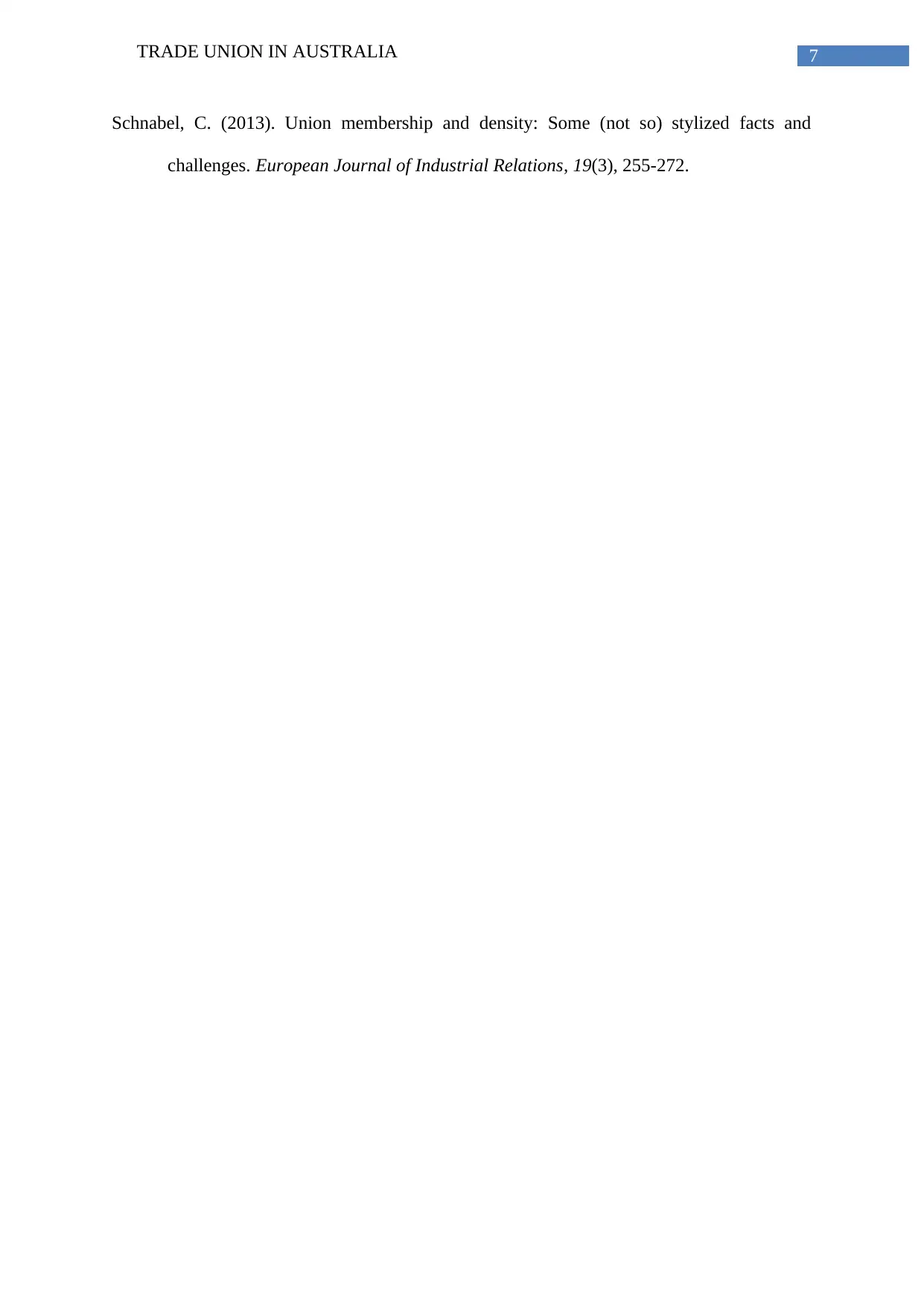
7TRADE UNION IN AUSTRALIA
Schnabel, C. (2013). Union membership and density: Some (not so) stylized facts and
challenges. European Journal of Industrial Relations, 19(3), 255-272.
Schnabel, C. (2013). Union membership and density: Some (not so) stylized facts and
challenges. European Journal of Industrial Relations, 19(3), 255-272.
1 out of 8
Related Documents
Your All-in-One AI-Powered Toolkit for Academic Success.
+13062052269
info@desklib.com
Available 24*7 on WhatsApp / Email
![[object Object]](/_next/static/media/star-bottom.7253800d.svg)
Unlock your academic potential
© 2024 | Zucol Services PVT LTD | All rights reserved.





